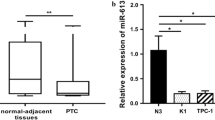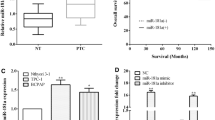Abstract
Papillary thyroid carcinoma (PTC) is the main kind of thyroid carcinoma, most of which are diagnosed in women. MiR-21 has been reported to be upregulated in multiple cancers to effect tumor growth. However, the role of miR-21 in PTC development remains unclear. In this present study, miR-21 and VHL expressions in PTC tissues and cells were evaluated by RT-qPCR and/or western blot. MTT assay and transwell assay were employed to assess cell proliferative and invasive abilities, respectively. Luciferase reporter assay was carried out to identify the target of miR-21and explore its roles in PTC. MiR-21 was upregulated in PTC tissues and cells. Ectopic of miR-21 expression promoted cell proliferative and invasive abilities, while knockdown miR-21 suppressed these in TPC-1 and BCPAP cells. Overexpression of miR-21 predicted poor prognosis in PTC. What is more, luciferase reporter assays showed miR-21 can directly target VHL in PTC cells. Knockdown of miR-21 expression inhibited TPC-1 and BCPAP cell invasion-mediated EMT and proliferation through the PI3K/AKT pathway. In addition, VHL reverses partial function of miR-21 on PTC cell proliferation and invasion. MiR-21 can inhibit cell proliferation and invasion by regulated VHL in PTC cells. The newly identified miR-21/VHL axis might provide a novel insight into the pathogenesis and therapy of PTC.





Similar content being viewed by others
References
Rahbari R, Zhang L, Kebebew E. Thyroid cancer gender disparity. Fut Oncol (Lond Engl). 2010;6(11):1771–9. https://doi.org/10.2217/fon.10.127.
Basolo F, Pisaturo F, Pollina LE, Fontanini G, Elisei R, Molinaro E, et al. N-ras mutation in poorly differentiated thyroid carcinomas: correlation with bone metastases and inverse correlation to thyroglobulin expression. Thyroid Off J Am Thyroid Assoc. 2000;10(1):19–23. https://doi.org/10.1089/thy.2000.10.19.
Ferlay J, Soerjomataram I, Dikshit R, Eser S, Mathers C, Rebelo M, et al. Cancer incidence and mortality worldwide: sources, methods and major patterns in GLOBOCAN 2012. Int J Cancer. 2015;136(5):E359–86. https://doi.org/10.1002/ijc.29210.
Kilfoy BA, Devesa SS, Ward MH, Zhang Y, Rosenberg PS, Holford TR, et al. Gender is an age-specific effect modifier for papillary cancers of the thyroid gland. Cancer Epidemiol Biomarkers Prevent. 2009;18(4):1092–100. https://doi.org/10.1158/1055-9965.epi-08-0976.
Sun K, Lai EC. Adult-specific functions of animal microRNAs. Nat Rev Genet. 2013;14(8):535–48. https://doi.org/10.1038/nrg3471.
Liu C, Su C, Chen Y, Li G. MiR-144-3p promotes the tumor growth and metastasis of papillary thyroid carcinoma by targeting paired box gene 8. Cancer Cell Int. 2018;18:54. https://doi.org/10.1186/s12935-018-0550-y.
Wang R, Ma Q, Ji L, Yao Y, Ma M, Wen Q. miR-622 suppresses tumor formation by directly targeting VEGFA in papillary thyroid carcinoma. Oncol Targets Therap. 2018;11:1501–9. https://doi.org/10.2147/ott.s156810.
Ma S, Jia W, Ni S. miR-199a-5p inhibits the progression of papillary thyroid carcinoma by targeting SNAI1. Biochem Biophys Res Commun. 2018;497(1):181–6. https://doi.org/10.1016/j.bbrc.2018.02.051.
Samsonov R, Burdakov V, Shtam T, Radzhabov CZ, Vasilyev D, Tsyrlina E, et al. Plasma exosomal miR-21 and miR-181a differentiates follicular from papillary thyroid cancer. Tumour Biol. 2016;37(9):12011–21. https://doi.org/10.1007/s13277-016-5065-3.
Saraggi D, Galuppini F, Fanelli GN, Remo A, Urso EDL, Bao RQ, et al. MiR-21 up-regulation in ampullary adenocarcinoma and its pre-invasive lesions. Pathol Res Pract. 2018. https://doi.org/10.1016/j.prp.2018.04.018.
Singh P, Srivastava AN, Sharma R, Mateen S, Shukla B, Singh A, et al. Circulating MicroRNA-21 Expression as a Novel Serum Biomarker for Oral Sub-Mucous Fibrosis and Oral Squamous Cell Carcinoma. Asian Pac J Cancer Prevent APJCP. 2018;19(4):1053–7. https://doi.org/10.22034/apjcp.2018.19.4.1053.
Su C, Cheng X, Li Y, Han Y, Song X, Yu D, et al. MiR-21 improves invasion and migration of drug-resistant lung adenocarcinoma cancer cell and transformation of EMT through targeting HBP1. Cancer Med. 2018. https://doi.org/10.1002/cam4.1294.
Frezzetti D, De Menna M, Zoppoli P, Guerra C, Ferraro A, Bello AM, et al. Upregulation of miR-21 by Ras in vivo and its role in tumor growth. Oncogene. 2011;30(3):275–86. https://doi.org/10.1038/onc.2010.416.
Huang YH, Lin YH, Chi HC, Liao CH, Liao CJ, Wu SM, et al. Thyroid hormone regulation of miR-21 enhances migration and invasion of hepatoma. Can Res. 2013;73(8):2505–17. https://doi.org/10.1158/0008-5472.can-12-2218.
Wang WJ, Yang W, Ouyang ZH, Xue JB, Li XL, Zhang J, et al. MiR-21 promotes ECM degradation through inhibiting autophagy via the PTEN/akt/mTOR signaling pathway in human degenerated NP cells. Biomed Pharmacotherap. 2018;99:725–34. https://doi.org/10.1016/j.biopha.2018.01.154.
Maxwell PH, Wiesener MS, Chang GW, Clifford SC, Vaux EC, Cockman ME, et al. The tumour suppressor protein VHL targets hypoxia-inducible factors for oxygen-dependent proteolysis. Nature. 1999;399(6733):271–5. https://doi.org/10.1038/20459.
Hoffman MA, Ohh M, Yang H, Klco JM, Ivan M, Kaelin WG Jr. von Hippel–Lindau protein mutants linked to type 2C VHL disease preserve the ability to downregulate HIF. Hum Mol Genet. 2001;10(10):1019–27.
Mallikarjuna P, Sitaram RT, Landstrom M, Ljungberg B. VHL status regulates transforming growth factor-beta signaling pathways in renal cell carcinoma. Oncotarget. 2018;9(23):16297–310. https://doi.org/10.18632/oncotarget.24631.
Chakraborty C, Mitra S, Roychowdhury A, Samadder S, Dutta S, Roy A, et al. Deregulation of LIMD1-VHL-HIF-1alpha-VEGF pathway is associated with different stages of cervical cancer. Biochem J. 2018;10:100. https://doi.org/10.1042/bcj20170649.
Stanojevic B, Saenko V, Todorovic L, Petrovic N, Nikolic D, Zivaljevic V, et al. Low VHL mRNA expression is associated with more aggressive tumor features of papillary thyroid carcinoma. PLoS One. 2014;9(12):e114511. https://doi.org/10.1371/journal.pone.0114511.
Kim E, Zschiedrich S. Renal cell carcinoma in von Hippel-Lindau disease-from tumor genetics to novel therapeutic strategies. Front Pediatr. 2018;6:16. https://doi.org/10.3389/fped.2018.00016.
Sondermann A, Andreghetto FM, Moulatlet AC, da Silva VE, de Castro MG, Nunes FD, et al. MiR-9 and miR-21 as prognostic biomarkers for recurrence in papillary thyroid cancer. Clin Exp Metab. 2015;32(6):521–30. https://doi.org/10.1007/s10585-015-9724-3.
Liwak-Muir U, Dobson CC, Naing T, Wylie Q, Chehade L, Baird SD, et al. ERK8 is a novel HuR kinase that regulates tumour suppressor PDCD4 through a miR-21 dependent mechanism. Oncotarget. 2016;7(2):1439–50. https://doi.org/10.18632/oncotarget.6363.
Zhang J, Yao T, Wang Y, Yu J, Liu Y, Lin Z. Long noncoding RNA MEG3 is downregulated in cervical cancer and affects cell proliferation and apoptosis by regulating miR-21. Cancer Biol Ther. 2016;17(1):104–13. https://doi.org/10.1080/15384047.2015.1108496.
Zhang KL, Han L, Chen LY, Shi ZD, Yang M, Ren Y, et al. Blockage of a miR-21/EGFR regulatory feedback loop augments anti-EGFR therapy in glioblastomas. Cancer Lett. 2014;342(1):139–49. https://doi.org/10.1016/j.canlet.2013.08.043.
Chen J, Gu Y, Shen W. MicroRNA-21 functions as an oncogene and promotes cell proliferation and invasion via TIMP3 in renal cancer. Eur Rev Med Pharmacol Sci. 2017;21(20):4566–76.
Zhang Z, Wang J, Wang X, Song W, Shi Y, Zhang L. MicroRNA-21 promotes proliferation, migration, and invasion of cervical cancer through targeting TIMP3. Arch Gynecol Obstet. 2018;297(2):433–42. https://doi.org/10.1007/s00404-017-4598-z.
Kaelin WG Jr. The von Hippel-Lindau tumor suppressor gene and kidney cancer. Clin Cancer Res. 2004;10(18 Pt 2):6290S–5S. https://doi.org/10.1158/1078-0432.CCR-sup-040025.
Author information
Authors and Affiliations
Corresponding author
Ethics declarations
Conflict of interest
All authors declare that they have no financial or other conflicts of interest in relation to this research and its publication.
Ethics approval
Ethics Committee of Affiliated Hospital of Qingdao University approved the research, and written informed consent was given by all participants.
Additional information
Publisher's Note
Springer Nature remains neutral with regard to jurisdictional claims in published maps and institutional affiliations.
Rights and permissions
About this article
Cite this article
Zang, C., Sun, J., Liu, W. et al. miRNA-21 promotes cell proliferation and invasion via VHL/PI3K/AKT in papillary thyroid carcinoma. Human Cell 32, 428–436 (2019). https://doi.org/10.1007/s13577-019-00254-4
Received:
Accepted:
Published:
Issue Date:
DOI: https://doi.org/10.1007/s13577-019-00254-4




